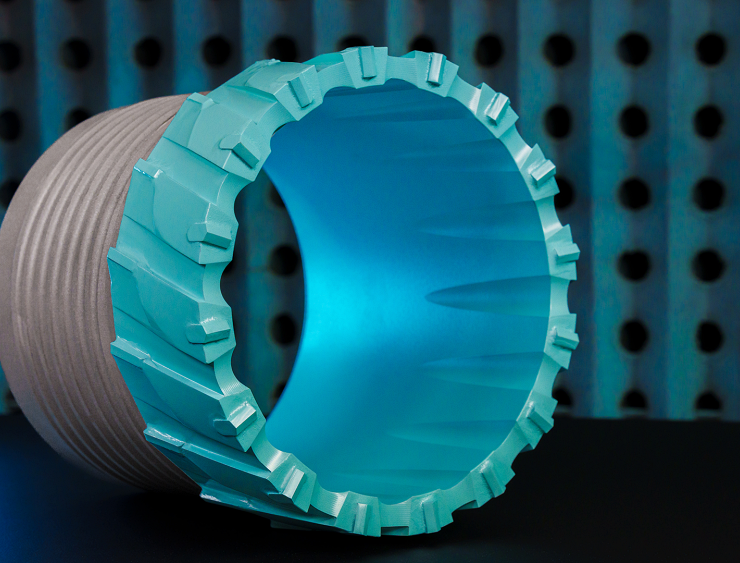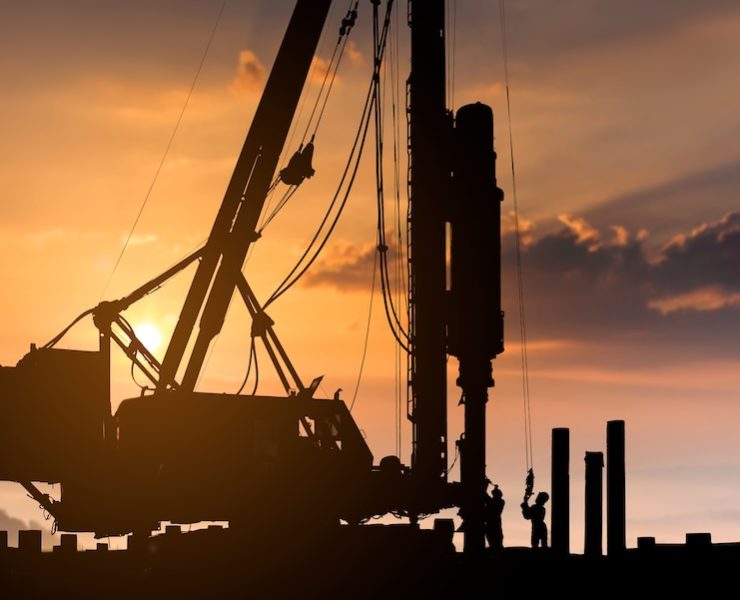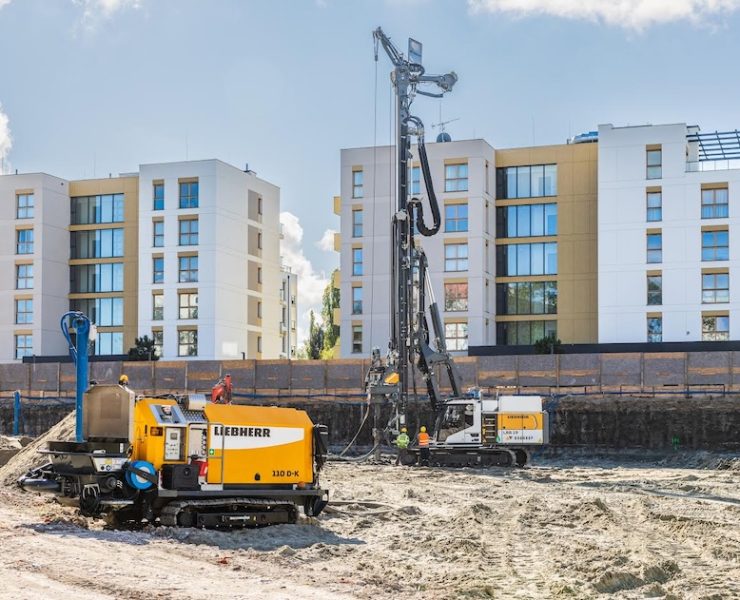Enhancing Structural Stability with Helical Tiebacks
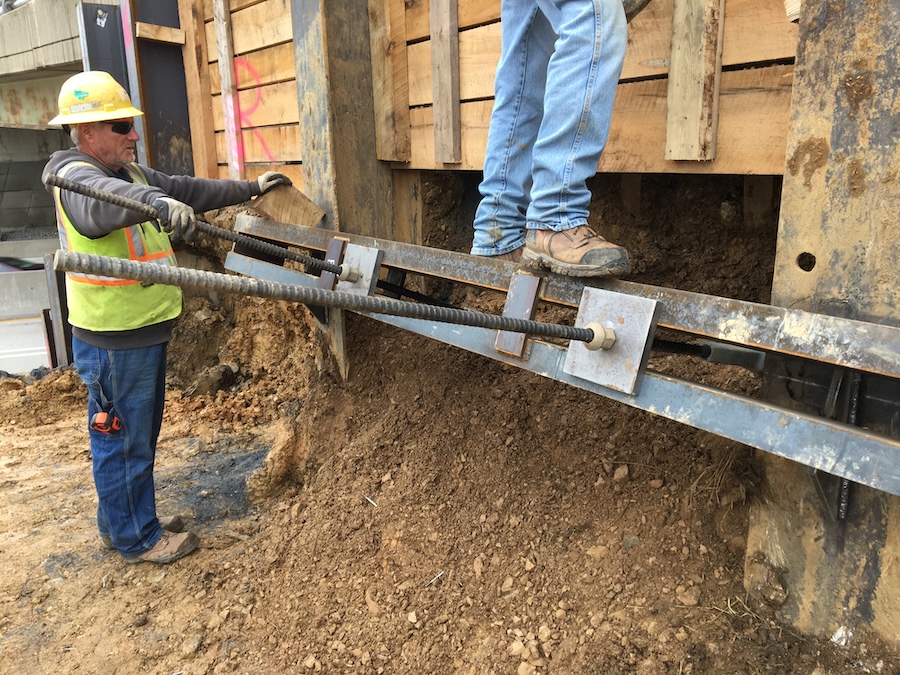
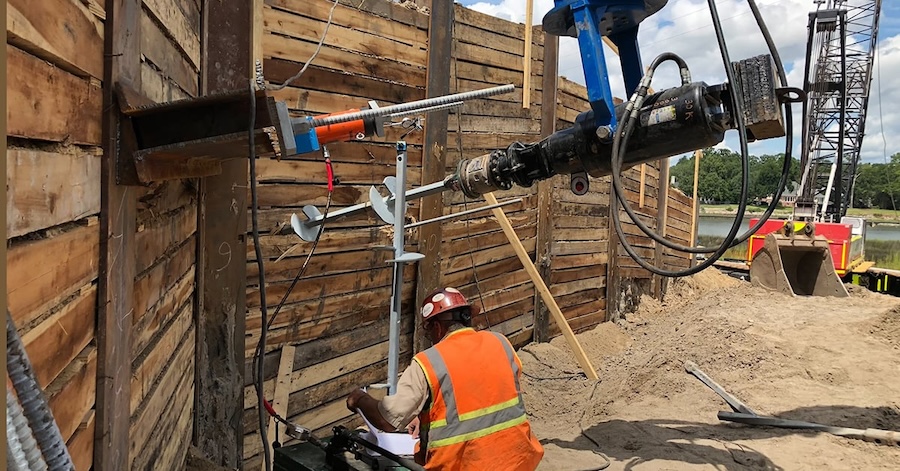
View the complete article here.
This guide is intended for engineers and contractors involved in deep foundation and stabilization projects. It provides an in-depth look at helical tiebacks—covering their components, how they work, various types, applications, benefits, and installation process. By understanding the use and troubleshooting of helical tiebacks, engineers and contractors can enhance the stability and reliability of their construction projects.
What are Helical Tiebacks?
Helical tiebacks are a type of deep foundation element used for providing lateral stability to various structures. They consist of a steel shaft with one or more helical plates welded to it. These helical plates resemble a screw or auger and allow the tieback to be twisted into the ground, anchoring it securely in place.
The basic components of helical tiebacks include:
- Shaft: The central steel rod that provides structural support.
- Helical plates: Spiral-shaped plates welded to the shaft, responsible for anchoring the tieback into the soil.
- Couplings and extensions: Used to extend the length of the tieback to reach the desired depth.
- Anchor head: The top part of the tieback where the load is transferred to the retaining structure.
How They Work (Mechanism of Load Transfer)
Helical tiebacks work by transferring lateral loads from the structure they are supporting into the surrounding soil. The installation process involves rotating the helical tieback into the ground using hydraulic torque motors, similar to driving a screw into wood. As the tieback is twisted into the soil, the helical plates create resistance against the surrounding earth—effectively anchoring the tieback in place.
The load transfer mechanism involves:
- Installation: The tieback is installed at an angle to the horizontal plane, ensuring it provides optimal support against lateral forces.
- Bearing capacity: The helical plates engage with the soil, providing bearing capacity that resists pullout forces.
- Load distribution: The load applied to the anchor head is distributed along the length of the shaft and through the helical plates into the soil.
Types and Variations
There are several types and variations of helical tiebacks, each suited for different applications and soil conditions:
- Single helix tiebacks: Consist of a single helical plate and are used for lighter loads and shallower installations.
- Multi-helix tiebacks: Feature multiple helical plates along the shaft, providing greater load-bearing capacity and stability for deeper installations.
- Solid shaft tiebacks: Made from a solid steel rod, these tiebacks offer higher strength and are suitable for dense or rocky soil conditions.
- Hollow shaft tiebacks: Lighter and easier to handle, these tiebacks are ideal for softer soils and less demanding applications.
Additionally, helical tiebacks can be customized with different helix diameters and spacings to match specific project requirements and soil conditions.
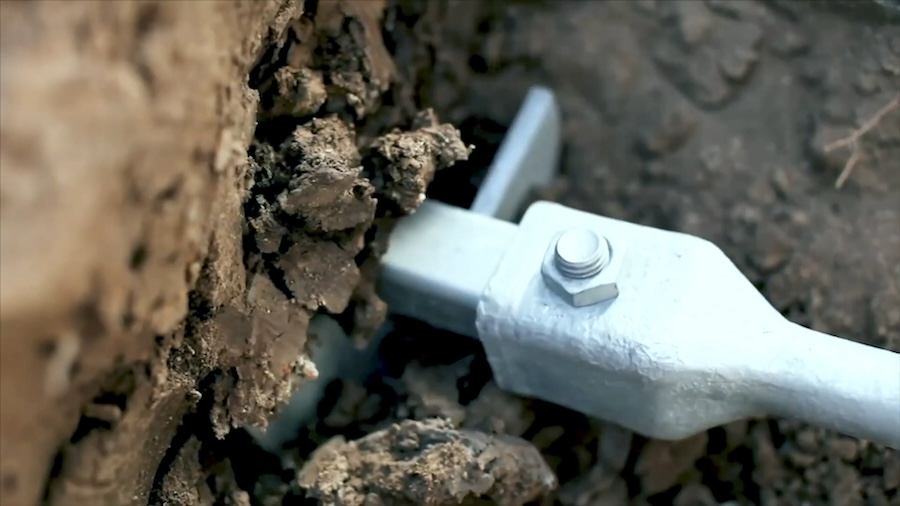
Applications of Helical Tiebacks
The ability of helical tiebacks to provide reliable lateral support makes them invaluable in various applications.
Retaining Walls
Helical tiebacks are used extensively in both temporary and permanent retaining walls. They provide essential lateral support, preventing soil movement and ensuring the stability of the walls. For temporary structures, such as those used during construction projects, helical tiebacks ensure safety by preventing soil collapse. For permanent retaining walls, they offer long-term stability—counteracting the lateral forces exerted by the retained soil.
Excavations
During deep excavations, the risk of soil collapse and wall failure is significant. Helical tiebacks are installed to provide lateral support to excavation walls, ensuring they remain stable and safe throughout the construction process. This application is critical in preventing accidents and maintaining the integrity of the excavation site.
Sea Walls and Bulkheads
In marine construction, sea walls and bulkheads are crucial for protecting shorelines and waterfronts. Helical tiebacks are used to anchor these structures, providing the necessary lateral support to withstand the forces of water and soil. Their use ensures the long-term durability and effectiveness of sea walls and bulkheads, safeguarding against erosion and structural failure.
Slope Stabilization
Slope stabilization is essential in preventing landslides and soil erosion in hilly or unstable terrains. Helical tiebacks anchor unstable slopes, providing resistance to lateral forces that could cause soil movement. This application is vital for protecting infrastructure and residential areas located on or near slopes.
Building Foundations
For buildings, especially those in areas prone to seismic activity or high winds, lateral forces can pose a significant threat to foundation stability. Helical tiebacks enhance the support of building foundations, ensuring they remain stable and secure against these forces.
Bridge Abutments
Bridge abutments require robust support to withstand the lateral forces exerted by the bridge structure and surrounding soil. Helical tiebacks provide this essential support, ensuring the abutments remain stable and intact. This application is critical for the overall safety and longevity of bridge structures, preventing movement and potential failure.
Involvement with Sheet Piling
Helical tiebacks are frequently used with sheet piling to provide enhanced lateral support in construction projects. Sheet piling involves driving interlocking sheets of steel, vinyl, or other materials into the ground to create a barrier for earth retention and excavation support. Common uses include retaining soil and water in excavations and waterfront structures, creating cofferdams for bridge and pier construction, and forming barriers to prevent soil movement and water infiltration.
Helical tiebacks anchor sheet piles to stable soil layers, providing additional lateral support. This combination enhances stability, increases load capacity, and can be used with various sheet pile materials. In deep excavations, sheet piles hold back soil and water, while helical tiebacks prevent lateral movement—ensuring wall stability and safety. In marine projects like docks and seawalls, sheet piles form barriers against water and soil, and helical tiebacks anchor them—protecting structures from erosion and wave action. For permanent retaining walls, sheet piles provide the main barrier, and helical tiebacks anchor them—distributing lateral loads and enhancing stability in challenging soil conditions.
The integration of helical tiebacks with sheet piling offers a robust solution for various construction and stabilization projects, providing enhanced stability and increased load capacity.
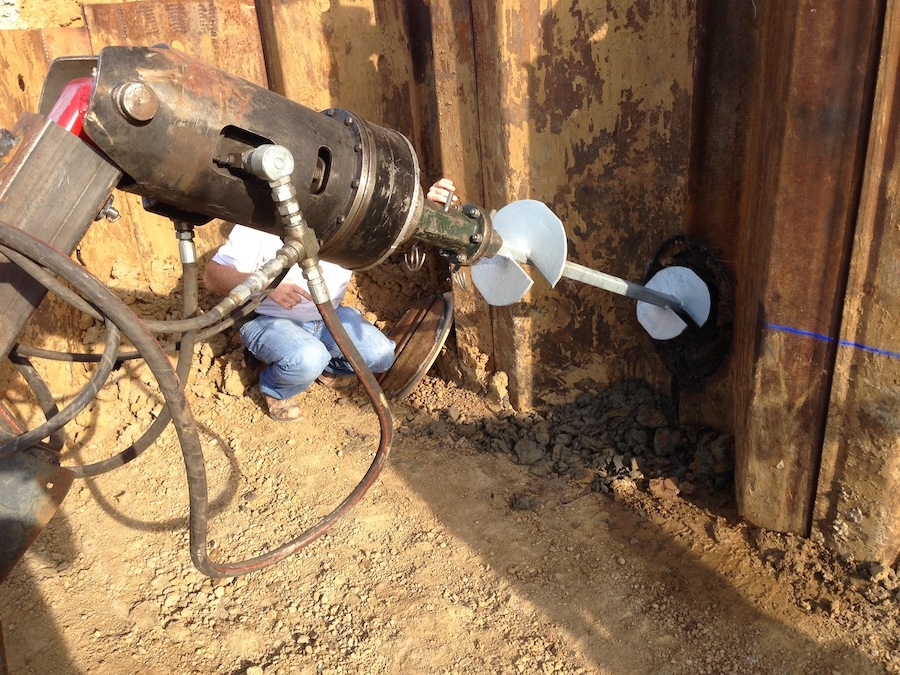
Installation Process
The installation of helical tiebacks involves careful planning, precise execution, and adherence to safety protocols to ensure their effectiveness and stability.
Pre-installation planning and site assessment: Before installation begins, a thorough site assessment and planning phase is crucial. This involves evaluating soil conditions, determining the load requirements, and designing the tieback system to meet the specific needs of the project. Site conditions such as accessibility, environmental impact, and existing structures are also considered to ensure a successful installation.
Step-by-step installation guide: Typical installation of helical tiebacks involves:
- Drilling: The installation process starts with drilling a pilot hole at the designated angle and depth. This hole guides the insertion of the helical tieback and ensures accurate placement. Specialized drilling equipment is used to create the hole with minimal disturbance to the surrounding soil.
- Insertion and anchoring: The helical tieback is then inserted into the pilot hole. Using hydraulic torque motors, the tieback is rotated into the ground—with the helical plates cutting into the soil and providing resistance. This twisting action continues until the tieback reaches the desired depth and achieves the necessary load capacity. Extensions and couplings may be used to achieve the required length.
- Load testing and verification: Once the tieback is in place, load testing is performed to verify its capacity and ensure it meets the design specifications. This involves applying a test load to the anchor head and monitoring the tieback’s response. Successful load testing confirms the tieback’s ability to handle the expected forces and provides assurance of its stability.
Safety considerations and best practices: Safety is paramount during the installation of helical tiebacks. Key safety considerations include:
- Ensuring all personnel are trained and aware of the installation procedures.
- Using appropriate personal protective equipment (PPE) such as helmets, gloves, and safety boots.
- Regularly inspecting equipment to ensure it is in good working condition.
- Monitoring the installation process for any signs of instability or issues.
- Implementing site-specific safety plans to address potential hazards.
Following these best practices helps prevent accidents and ensures a smooth and safe installation process.

Troubleshooting Common Issues
Helical tiebacks are reliable and effective, but like any construction element, they can encounter issues during installation and performance. Understanding how to diagnose and address these problems is essential for maintaining their integrity and functionality.
Misalignment occurs if the tieback is not installed at the correct angle or depth, leading to inadequate support. This can be diagnosed by checking the installation records against the design specifications. Solution: To address misalignment, the tieback may need to be reinstalled at the correct angle and depth. Using precise drilling equipment and verifying alignment during installation can prevent this issue.
Insufficient embedment depth happens when the tieback does not reach the required depth, resulting in not achieving the necessary load capacity. This issue can be identified through load testing and performance monitoring. Solution: Ensuring proper depth involves extending the tieback with additional sections if necessary. Pre-installation soil testing and accurate depth measurement during installation help achieve the required embedment depth.
Obstructions, such as underground rocks or debris, can impede the installation process—indicated by unexpected resistance during drilling or insertion. Solution: When obstructions are encountered, using appropriate drilling techniques or equipment to remove or bypass them is crucial. Conducting a thorough site survey before installation can help identify potential obstacles.
Excessive deflection occurs when the tieback deflects more than expected under load, indicating inadequate capacity or poor soil conditions. Monitoring the tieback’s movement under load helps diagnose this issue. Solution: To reduce deflection, additional tiebacks may be installed to share the load. Re-evaluating the load capacity and soil conditions can determine the best solution.
Soil creep is the gradual movement of soil around the tieback, reducing its effectiveness. Performance monitoring and soil surveys can detect soil creep. Solution: Mitigating soil creep requires installing additional tiebacks or soil stabilization measures. Monitoring soil movement and implementing geotechnical solutions can help maintain tieback effectiveness.
By diagnosing installation and performance problems accurately and implementing effective solutions, the longevity and reliability of helical tiebacks can be ensured.
View the complete article here.
What are helical tiebacks used for in construction?
Helical tiebacks are used to provide lateral stability to structures such as retaining walls, excavations, sea walls, and building foundations.
How do helical tiebacks work?
Helical tiebacks work by transferring lateral loads from the structure into the surrounding soil through their helical plates, which anchor them securely in place.














